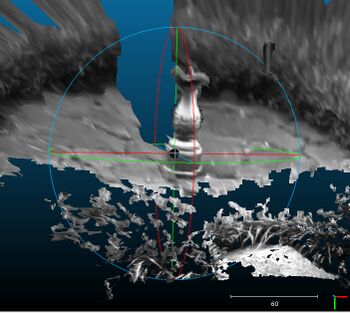Difference between revisions of "Example Stereo Mesh"
From BoofCV
Jump to navigationJump to search (Created page with "<center> <gallery heights=350 widths=350 perrow=4 > File:Example_disparity_mesh_cloudcompare.jpg| Mesh generated in BoofCV from stereo image displayed in Cloud Compare </galle...") |
m |
||
| (One intermediate revision by the same user not shown) | |||
| Line 1: | Line 1: | ||
<center> | <center> | ||
<gallery heights=350 widths=350 perrow=4 > | <gallery heights=350 widths=350 perrow=4 > | ||
File:Example_disparity_mesh_cloudcompare.jpg| Mesh generated | File:Example_disparity_mesh_cloudcompare.jpg| Mesh viewed in Cloud Compare and generated from a stereo disparity image. | ||
</gallery> | </gallery> | ||
</center> | </center> | ||
| Line 17: | Line 17: | ||
Related Examples: | Related Examples: | ||
* [[Example_Stereo_Disparity| Stereo Disparity]] | * [[Example_Stereo_Disparity| Stereo Disparity]] | ||
* [[Example Stereo Disparity 3D| Disparity to 3D Cloud]] | |||
= Example Code = | = Example Code = | ||
Latest revision as of 18:49, 2 September 2022
Shows you how to convert a disparity image into a 3D mesh. Meshes are typically easier to view in 3rd party libraries.
Example Code:
Concepts:
- Stereo Disparity
- Filtering
Related Examples:
Example Code
/**
* Example showing how you can convert a disparity image into a 3D mesh.
*
* @author Peter Abeles
*/
public class ExampleStereoMesh {
static int disparityMin = 5;
static int disparityRange = 60;
public static void main( String[] args ) {
String calibDir = UtilIO.pathExample("calibration/stereo/Bumblebee2_Chess/");
String imageDir = UtilIO.pathExample("stereo/");
StereoParameters param = CalibrationIO.load(new File(calibDir, "stereo.yaml"));
// load and convert images into a BoofCV format
BufferedImage origLeft = UtilImageIO.loadImage(imageDir, "sundial01_left.jpg");
BufferedImage origRight = UtilImageIO.loadImage(imageDir, "sundial01_right.jpg");
GrayU8 distLeft = ConvertBufferedImage.convertFrom(origLeft, (GrayU8)null);
GrayU8 distRight = ConvertBufferedImage.convertFrom(origRight, (GrayU8)null);
// rectify images
GrayU8 rectLeft = distLeft.createSameShape();
GrayU8 rectRight = distRight.createSameShape();
// Using a previous example, rectify then compute the disparity image
RectifyCalibrated rectifier = ExampleStereoDisparity.rectify(distLeft, distRight, param, rectLeft, rectRight);
GrayF32 disparity = ExampleStereoDisparity.denseDisparitySubpixel(
rectLeft, rectRight, 3, disparityMin, disparityRange);
// Remove speckle and smooth the disparity image. Typically this results in a less chaotic 3D model
var configSpeckle = new ConfigSpeckleFilter();
configSpeckle.similarTol = 1.0f; // Two pixels are connected if their disparity is this similar
configSpeckle.maximumArea.setFixed(200); // probably the most important parameter, speckle size
DisparitySmoother<GrayU8, GrayF32> smoother =
FactoryStereoDisparity.removeSpeckle(configSpeckle, GrayF32.class);
smoother.process(rectLeft, disparity, disparityRange);
// Put disparity parameters into a format that the meshing algorithm can understand
var parameters = new DisparityParameters();
parameters.disparityRange = disparityRange;
parameters.disparityMin = disparityMin;
PerspectiveOps.matrixToPinhole(rectifier.getCalibrationMatrix(), rectLeft.width, rectLeft.height, parameters.pinhole);
parameters.baseline = param.getBaseline()/10;
// Convert the disparity image into a polygon mesh
var alg = new DepthImageToMeshGridSample();
alg.samplePeriod.setFixed(2);
alg.processDisparity(parameters, disparity, /* max disparity jump */ 2);
VertexMesh mesh = alg.getMesh();
// Specify the color of each vertex
var colors = new DogArray_I32(mesh.vertexes.size());
DogArray<Point2D_F64> pixels = alg.getVertexPixels();
for (int i = 0; i < pixels.size; i++) {
Point2D_F64 p = pixels.get(i);
int v = rectLeft.get((int)p.x, (int)p.y);
colors.add(v << 16 | v << 8 | v);
}
// Save results. Display using a 3rd party application
try (OutputStream out = new FileOutputStream("mesh.ply")) {
PointCloudIO.save3D(PointCloudIO.Format.PLY, mesh, colors, out);
} catch (IOException e) {
throw new RuntimeException(e);
}
}
}
